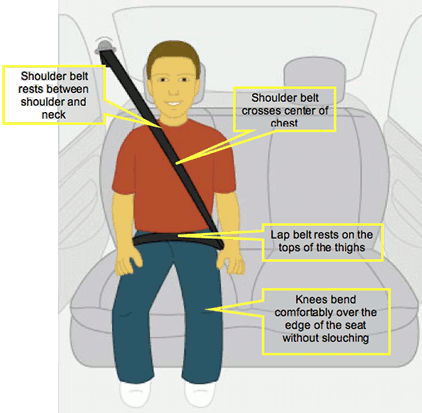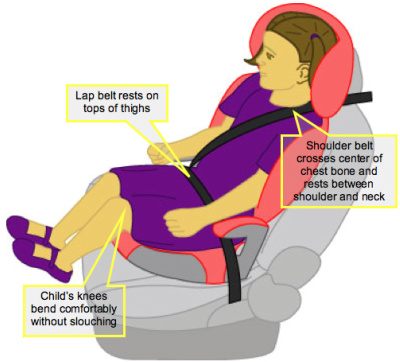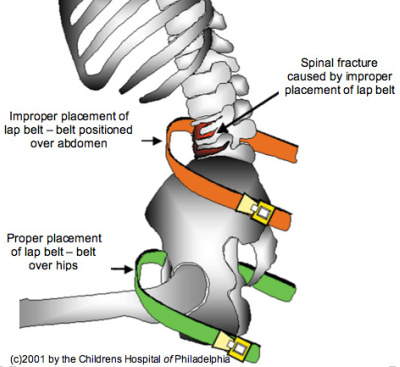This page has moved, please see Booster Science: How and Why Boosters Work to find out why kids can’t just use the seat belt.
Kids need to use boosters because the seat belt does not fit them correctly without the booster. If the seat belt doesn’t fit the child, he is at risk for injury; in fact a child between ages 4 and 8 riding in a booster is 59% less likely to be injured in a crash than a 4 to 8 year old wearing a safety belt alone. Read on to learn what seat belts do and why they don’t automatically work for kids.
 What the seat belt does
What the seat belt doesThe safety belt has two very important jobs:
In order to work properly, the safety belt needs to rest on the strong bones of the body – the collar bone (clavicle), chest bone (sternum), and hip bones (pelvis). Softer parts of the body – such as the belly (abdomen) – are not strong enough to withstand the extreme forces in a crash. It’s very important that the safety belt does not rest on these soft parts, since injuries may result. In order for the seat belt to work–to prevent you from being ejected and to distribute the crash forces–it needs to fit you like it fits the man in this picture. Unfortunately, seat belts do not fit kids under ages 10 to 12 this way.
There are three main problems with vehicle safety belts and children. These three factors combine together in a crash to create an extremely unsafe situation which can only be corrected by the use of a booster.
The shoulder belt is usually anchored so high up in the vehicle (even with adjustable shoulder belt anchors in many newer vehicles) that instead of crossing the center of a child’s chest and resting between the neck and the shoulder, it crosses only a small part of the chest and rests against the neck. This causes the child to be uncomfortable and most kids respond by putting the shoulder belt behind their backs or under their arms. If the shoulder belt is not going across the child’s chest and shoulder, it cannot hold the child’s upper body back in a crash–allowing the possibility of severe head, neck or spinal injury.
 Problem 2: The vehicle seat is too big and too deep
Problem 2: The vehicle seat is too big and too deepThe vehicle seat is too deep for most kids to be able to sit comfortably without slouching – since their thigh bones (femurs) are too short. Slouching worsens the already poor belt fit by placing the lap belt further up on the abdomen and moving the shoulder belt even further off the chest and onto the neck. By creating a big gap between the child’s back and the back of the vehicle seat, slouching introduces a large amount of slack in the safety belt, which can allow a child’s head and body to move dangerously far forward in a crash.
A child’s pelvis (hip bones) is relatively small and cartilaginous and lacks the prominent anterior superior iliac spines of an adult’s. Try to feel your hip bone. What you’re touching is the anterior superior iliac spine–the part that sticks out the farthest. If you try to feel a child’s hip bones, it’s much more difficult (even though many kids are very skinny) because the iliac spine is not fully formed until about age 8-10.
An adult’s iliac spine keeps the seat belt on his hips and prevents the lap belt from going into the abdomen. Unfortunately, a child’s small pelvis, lacking the fully developed iliac spine, is often unable to prevent the lap belt from riding up into the abdomen. The lap belt may start out in the proper position but moves up into the abdomen during the crash, leading to a pattern of injuries to the abdominal organs and lower spinal cord known as “seat belt syndrome. These injuries are severe and life-changing.

The correctly placed green belt rests on the hips, over a bony area of the body.
The incorrectly placed orange belt has moved up around the child’s abdomen. It’s easy to see how the spinal cord is in danger as the orange belt tightens against the soft abdomen and pushes on the spinal cord. You can also see how the soft organs inside the abdominal area would be at great risk for injury.
